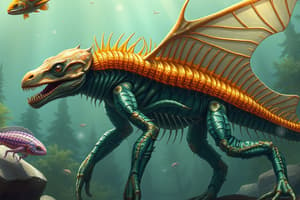Podcast
Questions and Answers
Which group of animals lacks a backbone?
Which group of animals lacks a backbone?
- Invertebrates (correct)
- Mammals
- Fish
- Reptiles
What is the main characteristic shared by fish, amphibians, reptiles, birds, and mammals?
What is the main characteristic shared by fish, amphibians, reptiles, birds, and mammals?
- Exoskeleton
- Coelom
- Shell
- Vertebral column (correct)
Which one of these animals is NOT an invertebrate?
Which one of these animals is NOT an invertebrate?
- Arachnid
- Nematode
- Fish (correct)
- Cnidarian
What structure provides support and protection for arthropods?
What structure provides support and protection for arthropods?
Which group of animals has a central nervous system consisting of a brain and spinal cord?
Which group of animals has a central nervous system consisting of a brain and spinal cord?
What is the main significance of classifying animals into invertebrates and vertebrates?
What is the main significance of classifying animals into invertebrates and vertebrates?
Which of the following is NOT a significance of classifying animals into invertebrates and vertebrates?
Which of the following is NOT a significance of classifying animals into invertebrates and vertebrates?
Why is it important for ecologists to understand the classification of animals into invertebrates and vertebrates?
Why is it important for ecologists to understand the classification of animals into invertebrates and vertebrates?
What is a limitation/challenge associated with the classification of animals into invertebrates and vertebrates?
What is a limitation/challenge associated with the classification of animals into invertebrates and vertebrates?
How does the classification of living organisms into invertebrates and vertebrates contribute to conservation efforts?
How does the classification of living organisms into invertebrates and vertebrates contribute to conservation efforts?
Study Notes
Classifying Living Organisms: Invertebrates and Vertebrates
As we venture into the astounding world of life forms, one crucial aspect of biology is classifying organisms based on shared traits and characteristics. Two major groups within the animal kingdom are invertebrates and vertebrates. Understanding these groups, their distinguishing features, and their implications for the broader biological world will lay a strong foundation for our exploration into the realm of classification.
Invertebrates
These animals, which lack a backbone, form the majority of animal life on our planet. Invertebrates encompass a diverse range of species, such as insects, arachnids, mollusks, crustaceans, nematodes, and cnidarians. They exhibit a wide array of body plans and environment adaptations.
Invertebrates lack a vertebral column, but they do have other structures that provide support and protection. For example, arthropods have an exoskeleton made of chitin, while mollusks have a shell or a soft body covered with a hard protective layer. Invertebrates also vary greatly in their body organization, with some having segmented bodies and others possessing a single body cavity or coelom.
Vertebrates
This group of animals, which includes fish, amphibians, reptiles, birds, and mammals, shares a common trait: they all have a backbone, or vertebral column. Vertebrates have a central nervous system, which includes a brain and spinal cord. They also have a highly developed sensory system that allows them to perceive their environment.
Vertebrates have complex body structures. For example, fish have fins and a streamlined body that allows them to swim efficiently. Reptiles have scales for protection, while birds have feathers for flight and thermoregulation. Mammals possess a wide variety of highly specialized body structures, such as fur, hair, and specialized teeth.
Significance and Implications
The classification of invertebrates and vertebrates is significant for several reasons. It provides a framework for understanding the evolutionary relationships between different groups of animals and the ecological roles they play.
-
Simplifies biological organization: Classifying animals into these two groups helps biologists to sort the enormous variety of life forms into manageable categories.
-
Fosters scientific communication: By using a standardized system of classification, biologists can effectively communicate their observations, discoveries, and theories with one another.
-
Informs ecological studies: Understanding the classification of animals allows ecologists to study the interactions between organisms, such as predator-prey relationships, competition, and symbiosis.
-
Provides a basis for evolutionary studies: The classification of invertebrates and vertebrates helps biologists to trace the evolutionary history of different groups of animals and the mechanisms that drive their diversification.
-
Guides conservation efforts: Classification provides a way to identify and protect animals that are at risk of extinction, such as endangered and critically endangered species.
Challenges and Limitations
Despite the numerous benefits of classifying animals into invertebrates and vertebrates, there are some limitations and challenges associated with this system.
-
Exceptions to classification: Some animals appear to straddle the line between invertebrates and vertebrates, such as lancelets, which have a notochord but no vertebral column.
-
Evolutionary relationships: The classification of animals into invertebrates and vertebrates is a simplification of the evolutionary tree of life. As we continue to uncover new species and learn more about their evolutionary relationships, the classification system may need to be revised.
Conclusion
The classification of living organisms into invertebrates and vertebrates forms a fundamental framework for understanding the diversity of life forms and their evolutionary relationships. This system promotes scientific communication, fosters ecological studies, and guides conservation efforts. However, this system is not without its limitations, and it may need to be revised as we continue to uncover new species and learn more about their evolutionary history.
Studying That Suits You
Use AI to generate personalized quizzes and flashcards to suit your learning preferences.
Description
Test your knowledge on the classification of living organisms into invertebrates and vertebrates. Explore the defining features, body structures, and ecological significance of these two major animal groups.




